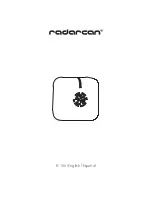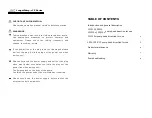
Any parameter that can be voltage controlled will have at least two control dials plus one or more
CV input. One dial (typical colour Red/Orange) will act as the Master control, sweeping the
function over its typical range, while the blue Modulation Depth control will set the amount of
modulation from its respective CV input. Some modules have an additional 'full-range' CV input
without level control, with these typically being for unattenuated or 1V/Oct response.
Blue controls are typically 'attenuverting' – a combination of Attenuating and Inverting – to allow
detailed modulation possibilities. Moving from the central zero position, clockwise rotation gives
increasing modulation to unity (times one), while moving anti-clockwise inverts the modulation
signal up inverted unity (times minus one). [Note that it can be hard to dial in exactly zero
modulation via the dial – in such cases, the input cable can easily be removed for true zero.]
When considering inversion, note that it occurs around the 0V centre so unipolar or bipolar signals
will behave as follows:
It is important to consider the waveform's behaviour when applying it as a modulation signal. The
modulation voltage (after input attenuverter) is summed with the value set by the main control dial,
with positive voltages adding to the main sum and negative voltages subtracting. As such:
•
A b/-5V signal will add and subtract from the master control setting.
For full control sweep, set the main control to a central position with CV full (or inverted).
•
A 0 to +10V signal will add to the master control setting.
For full control sweep, set the main control to zero and apply full positive CV modulation.
•
An inverted unipolar signal (0V to -10V) will subtract from the master control setting.
For full control sweep, set the main control to full and apply full inverted CV modulation.
As previously mentioned, signals are generally output at full 10V p-to-p amplitude allowing them to
be split to more than one different destination, with the possibility of different attenuation settings
at each destination. Banana cables allow quick and easy stacking of connections with the proviso:
You can split one signal to several different destinations
Eg: The output of a VCO could be patched both to the Main Path input of a
VCF and also to the Frequency Modulation CV input
but
You cannot combine more than one signal into one input
Eg: Two VCO outputs should not be combined by 'mixing' at the VCF's main
path input – use a mixer (eg. DC Mixer in Dual Mixing module)
Saying that, all outputs feature a universal output impedance (470 ohms) and built in short-circuit
protection – so 'passive' / 'stack' mixing can be experimented with, it just won't give 'proper'
results.





























